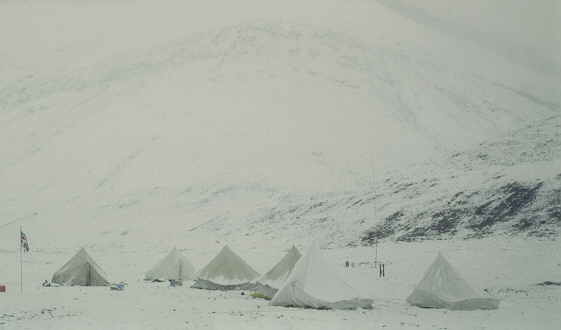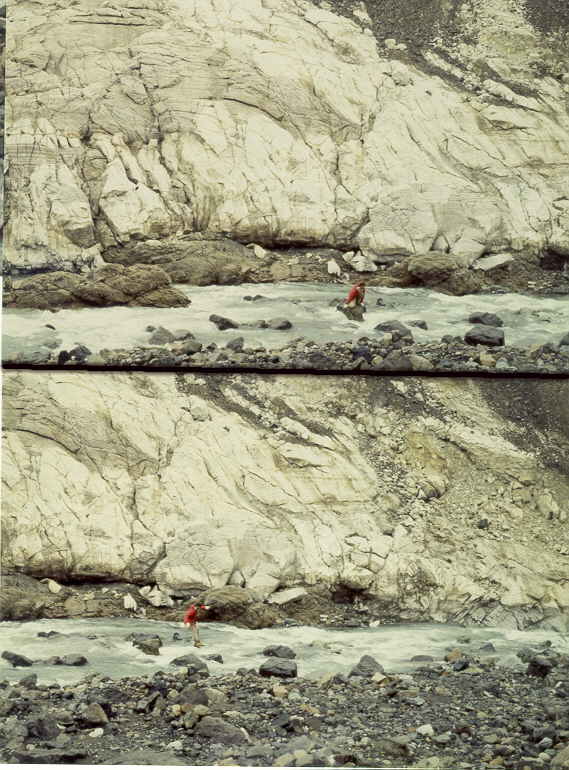Home page: www.treks.org
Table
of Contents "On the road to Kabul and other short stories of treks"
Treacherous glacier stream
crossings on Ellesmere Island, July 1989
What to do
Matt, Jeff and
the Steve crossed a stream in the
morning at waist level. On returning at night the water level of the fast
flowing stream came to their shoulders. Luckily they fixed a rope but crossing
the deep stream to get back to the camp did not look inviting. What to do, wait
12 hours for the nightly water level to drop, or try it?

Crossing a glacier
stream with hip-waders, Eastern Axel Heiberg Island, July 1982.

Crossing a glacier
stream, using a pole for support. Western Axel Heiberg Island, July 1983.
Glacier Streams
Glacier streams in Northern
Canada are fed by melt water and the thawing tundra and the water temperature
is always close to freezing. Crossing bare-feed is impossible as your feet get
numb instantly and without any feeling you would cut your feet on the rocks.
Rubber hip waders are essential to cross. Often, you also need a pole for
stability and the radio mast tube or tent pole are ideal.
It is not recommended to
wear a pack-sack in case you trip as landing on your back would make you as
helpless as a turtle on its back. In the morning the water level is the lowest
and at night higher. Some are so large you cannot cross them unless during
sudden cold weather and you need a camp move by helicopter.
Season of snow
The 1989 expedition
on Northern Ellesmere Island was the year of snow, snow and even more snow.[1][2][3]

Camp on Ellesmere
Island, during yet another snow storm, July 1989.
Freak
weather systems kept on rolling in from the South and covered the mountains in
a near permanent layer of up to two meters of snow. Only close to sea level the
snow would melt.
This is
very unusual for this area, as it is know to be a dry Arctic desert by the
prevailing Northern wind caused by the polar high pressure system. Average
yearly precipitation is only 50 mm.
Warm day
Mid July, after several days of snow the
temperature suddenly rose to 18 degrees Celsius at sea level, presumably by
freak warm weather moving in from the South. This started a massive run-off of
water in the lower snow-covered areas.
I was
camping higher up in the mountains surrounded by glaciers with a French Professor and his son. It was still fine
to cross the glacier streams as the weather is colder, around 10 Celsius,
although the water level was relatively high. Luckily, this time we did not
cross one of the major streams coming down from the glaciers in the morning,
see below.

Typical jump across the
largest glacier stream in the high camp near the glaciers, July 1988.
Deep Stream
Further
North, Matt, Jeff and Steve were camping near a major stream almost at sea
level. They crossed the stream in the morning at waist level using the
hip-waders. This is tricky as the water level is higher at night by the warmer
sun during the day, rising from 20 degrees at midnight to 30 degrees at noon.
When they
returned back to the camp in the evening, the fast flowing stream reached their
shoulders. Luckily they fixed a rope in the morning for safety in the morning
and was not very cold as it was mostly melted snow by the warm weather. Jeff
and Mat crossed safely.
Steve, as
always, was wearing a heavy packsack and the shotgun when crossing. When he got
half way, the rope snapped and the fast current dragged him along. Luckily he drifted to the camp
side while desperately clinging on to the rope. He is pretty strong and holding
on to the rope saved his life. Wearing a packsack in a fast flowing stream
makes you as helpless as a tortoise on its back and you drown,
The same
night I tried to talk to them on the
radio as we do every night. There was little response, a bit of mumbling and
they kept it very short. They did not
tell me what happened and I though they were playing a joke, being tired after
six weeks of field work in the snowy weather. This did not change in the next
few days and I got the feeling they went on a passive strike being fed up with
the work.
A week later

Typical weather in the
high camp near glaciers and mountains in July 1989. To the right one of the
glacier tongues. Somebody sitting in the foreground feeling cold.
Moving to
Eureka was difficult. First the French professor and his son were moved to
another camp nearby. I kept only minimal gear like food for a few days, a
radio, a shotgun, a sleeping bag and a tent. Jeff would be picked up in the
other camp and together we would fly to Eureka, a distance of 100 km. When I
was waiting for the helicopter, the clouds suddenly came down and it started
snowing. This is tricky as the camp in a deep valley of a rugged mountain and
glacier area and the helicopter had to cross the mountain range with white
glaciers difficult to see in the clouds. The helicopter pilot was not happy
after he finally found me in the snowy clouds in the mountainous stream valley
after flyuing down from the mountain range. I should have radioed him not to
try it and be prepared to spend the night alone in the field, highly unusual
and tricky with so little equipment.
Once the helicopter landed,
flying to Eureka was easy as we only had to follow the down stream valley
South.

Typical weather in the
high camp near glaciers and mountains. Down-stream valley South for flying to
Eureka. Glacier tongue left covered in snow. July, 1989.
Jeff told
me the full story of the near fatal stream crossing. They were unable to work
since the incident, being in a state of chock and were only recovering. This
was the closest call in loosing a life on one of the expeditions I participated
in Canada. 10 years later in the Himalaya it did happen, on Island Peak at 6000
m when a German died of high altitude sickness.
When to cross a glacier
stream
The golden rule I tried to tell my students
in crossing streams was not to cross above knee level in the morning as it
would be much higher at night. Inexperience combined with freak weather caused
this incident.
Another
rule was to never wear a packsack when crossing a deep stream but to throw is
across as it makes you totally immobile when falling in a stream but to throw
it over the stream. The shot gun you should always leave home as it is to heavy
and could be damaged. There are no polar bears in the mountains and only rarely
along the coast. Wolves are always very shy and keep a large distance.
You are visitor #![]() since August 2004.
since August 2004.